Traditional Brazilian Food
Brazilian cuisine is known for dishes that are rich in color and diverse in flavor. The country is a true melting pot of different traditions and cultures, and that is reflected in its cuisine. Typical Brazilian dishes are different in almost every region, and they’re usually made from ingredients that are easy to source in that specific region.
Some staples are popular all over the country and despite the many different regions and the countless recipe variation, they’ve even managed to agree on a national dish!
Read on to learn more about traditional Brazilian food, and see all the savory and sweet delicacies that you should absolutely try when you get the chance!
Tapioca
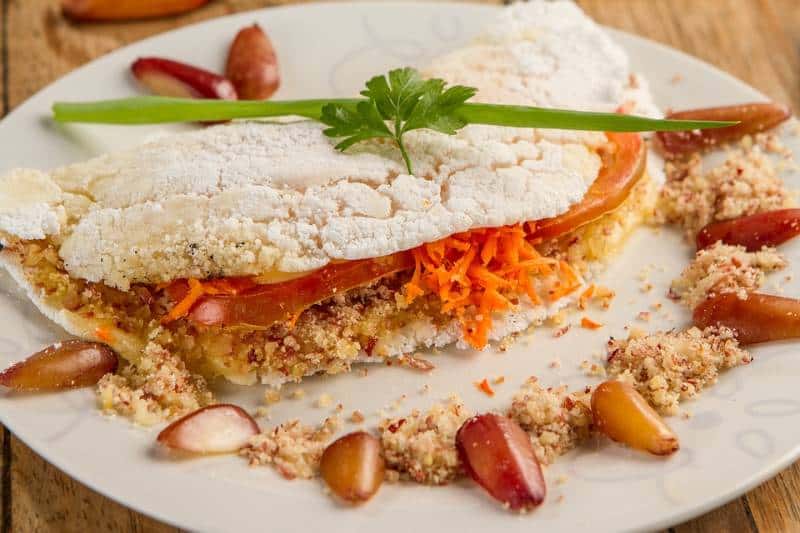
Tapioca is a very popular Brazilian snack. Brazilian tapioca usually refers to pancakes that are made with tapioca flour. They have a very chewy texture, and they can be sweet or savory, depending on the toppings.
The recipe for tapiocas is incredibly simple – you just need some tapioca flour (cassava flour can be used as an alternative) and water. Mix the two ingredients together, let the mixture rest for an hour, and then just pour out the water. The starch should have activated, and the mixture should have a gummy texture.
Then it’s time to get rid of the excess water – tap it dry with a towel until it starts to look like chalk. Then crush the mixture into pieces, strain it, and fry it in a pan!
Top it off with some butter, coconut milk, Brazilian soft cheese, grated coconut, or anything else you feel like eating!
Pamonha
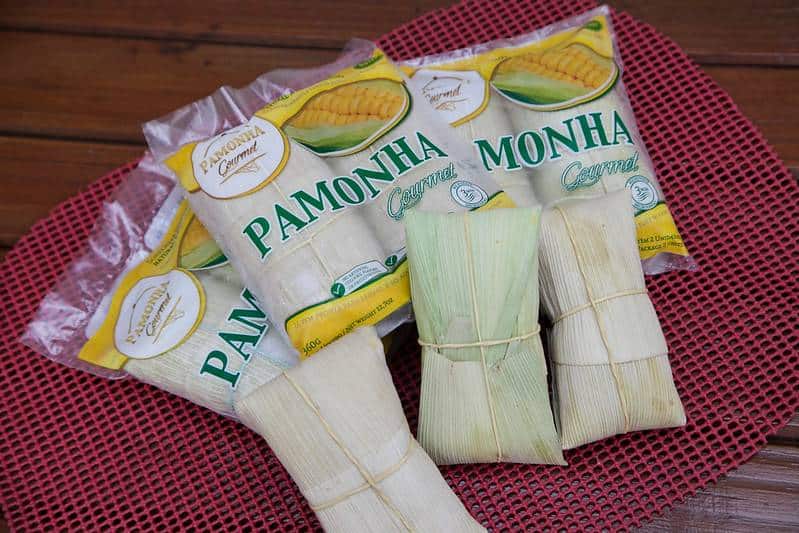
Pamonha is a traditional Brazilian dish that’s mostly made from sweet corn. It’s prepared by grating the sweet corn kernels and boiling them in coconut milk until a paste-like texture is achieved.
At least, that’s the traditional way of making this typical dish from Brazilian cuisine. Some modern recipes will just have you mix the sweet corn and coconut milk in a blender, and then mix them with sugar and melted butter.
The paste should be served wrapped in corn husks, preferably the ones from the corn that was used to prepare the Pamonha.
Pão de Queijo (Cheese Bread)
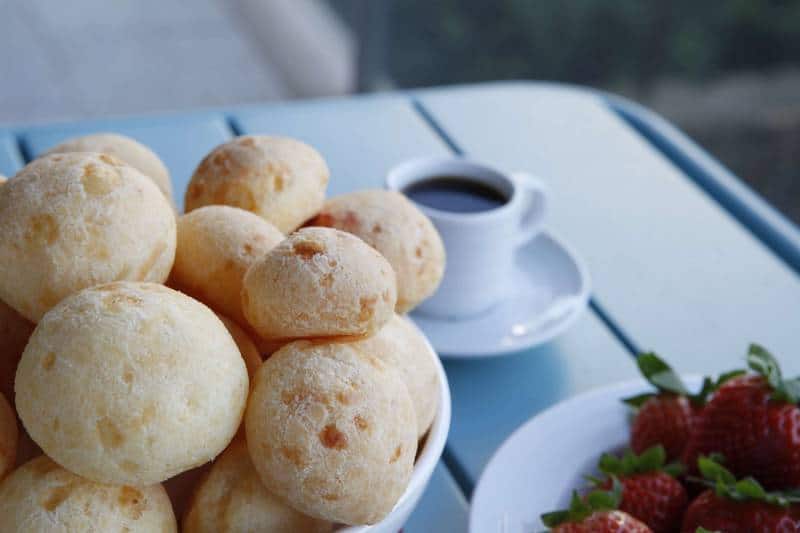
Pão de Queijo is a popular Brazilian snack that’s usually eaten for breakfast. It’s an inexpensive snack that’s often sold by street food vendors, and it’s pretty simple to make.
Pão de Queijo is a roll of cheese bread/cheese bun, usually made with cassava starch and Minas cheese. The exact ingredients differ from region to region, but most recipes require cassava starch, some type of fat (butter, lard, vegetable oil, etc.), cheese (Minas cheese, mozzarella, parmesan, etc.), and an egg.
The egg gives the dish its staple color, and it also enhances the flavor. The cheese is the key ingredient in terms of taste, and Minas cheese is the traditional choice because this dish originates from the Minas Gerais region.
Cassava flour is key for the Pão de Queijo texture – the starch is what makes the buns so fluffy, even if they’re not leavened. Also, since they’re made with cassava flour and not wheat flour, these cheese rolls are usually gluten-free!
The buns are about 3-5 centimeters in diameter, and they expand while they’re baking. Each bun only has about 50 calories on average, so they’re a much healthier snack than they appear!
Brigadeiro

Brigadeiro is a traditional dessert in Brazilian cuisine, and it’s a type of chocolate truffle. The exact origin of the dish is not known, but it’s assumed that Brigadeiro was first created by a Rio de Janeiro confectioner.
This Brazilian dish is a must-try for all foodies and chocolate lovers. It’s made with butter, cocoa powder, and sweet condensed milk, and it can be served either hot or cold. They’re best served cold (chilled), and if they’re served hot, the truffles are eaten with a spoon.
Although there are lots of variations of the Brazilian chocolate truffles, they’re usually made with just three ingredients, shaped into balls, and then entirely covered with chocolate sprinkles.
The sprinkles are optional, but they add quite a bit of texture to the Brigadeiro, which is why most recipes use them.
Feijoada
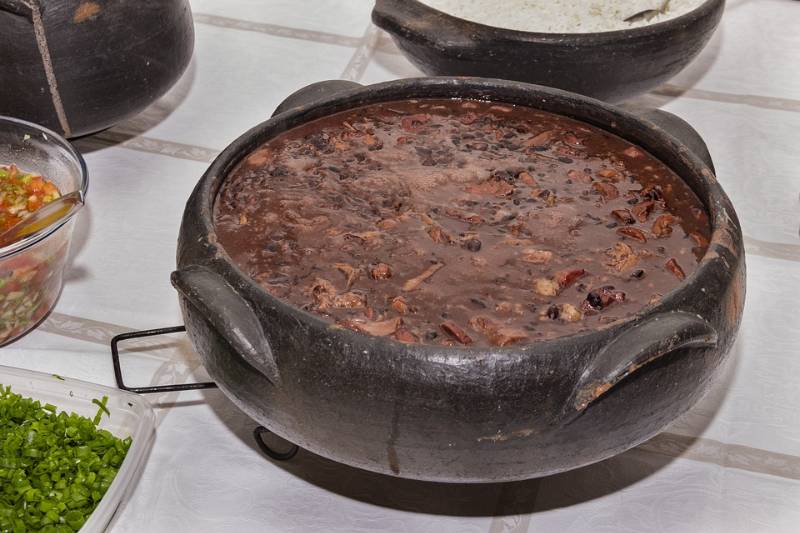
Feijoada is a type of beef stew that’s very popular in Brazil. Like many other traditional Brazilian dishes, feijoada originated in Portugal, and it’s actually named after the Portuguese word for beans.
This Brazilian dish is made with beef, pork, and black beans. It tastes best when it’s left to simmer for hours on low heat, preferably in a thick clay pot. Feijoada is traditionally served with rice and sausages; the sausages can be cooked in the stew, but it’s not always necessary.
Feijoada is often considered the national dish of Brazil, mostly because it has such a rich history. It’s popular in pretty much all the different regions of the country, and each region has its own twist on this traditional Brazilian food.
The main thing that differs in the feijoada from region to region is the type of bean in the stew. In the southeast regions, the stew is traditionally made with black beans, but red or brown beans are more popular in the central-east regions of Goias, Sergipe, and Bahia.
Additionally, the feijoada recipes that are commonly prepared in Sergipe and Bahia usually call for some extra vegetables. This includes plantains, potatoes, kale, cabbage, carrots, and even pumpkin, and they’re usually added towards the end of the cooking process.
The vegetables are specific to these two regions – in the rest of Brazil, feijoada is usually prepared with just meat and beans.
Moqueca de Pirarucu
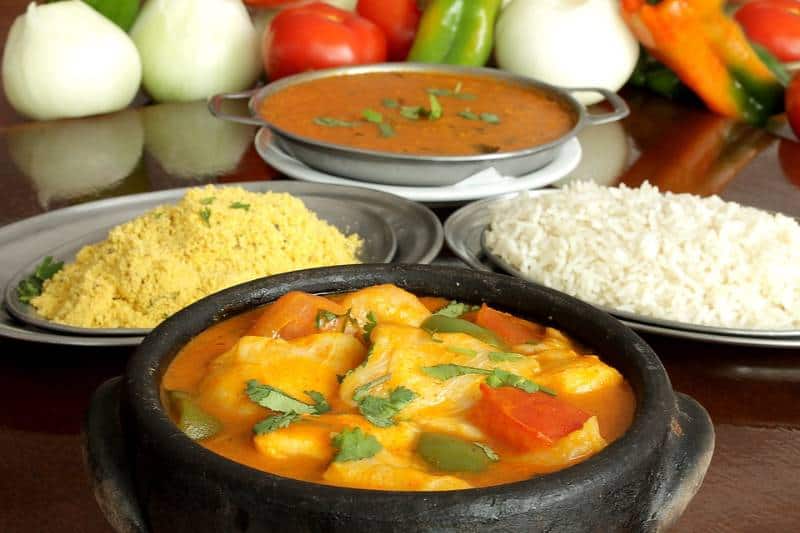
Moqueca is a fish stew and Pirarucu is a type of fish that’s commonly found in the Amazon river. So, Moqueca de Pirarucu is a fish stew made with this specific type of fish that’s common in northern and northwestern Brazil.
It’s worth noting that Moqueca is eaten in all parts of Brazil and that it can be prepared with pretty much any type of fish you have handy. It tastes best when it’s cooked slowly in a terracotta pot because this cooking method really allows all the different flavors in the dish to come out.
In addition to Pirarucu (or any other type of fish), tomatoes, garlic, coriander, lime, and cilantro are also considered staple ingredients in the stew.
Salpicão de Frango
Salpicão de Frango is a chicken salad that’s very popular in Brazil, especially around Christmas time. It’s one of the country’s most famous dishes, and there are quite a few different variations of the traditional recipe.
Most recipes call for chicken breast, but it’s worth noting that the salad is just as delicious if it’s made from other parts of the chicken.
The recipe calls for shredded chicken (breast), fresh vegetables, mayo dressing, and raisins, which are supposed to add a bit of sweetness to the salad.
All the ingredients are mixed, and the salad is topped with Batata palha – the deep-fried potato sticks that seem to be a staple ingredient in most Brazilian recipes.
The only tricky part of this dish is preparing the meat properly. You’re supposed to season the chicken generously first, then sautee it in olive oil until it’s seared on both sides, and then cook it in stock for about 20 minutes.
This allows the meat to soak up all the flavors from the seasoning so that once you’ve shredded the chicken, every little piece is equally flavorful and delicious.
Acarajé

Acarajé is a type of street food that’s popular in West African and South American countries. The dish is very common in Brazil, particularly in the northeastern parts of the country. If you’re ever in Salvador, you’ll notice that nearly every street food vendor is selling Acarajé.
This traditional Brazilian dish is made from black-eyed peas that are ground, beaten, and formed into small balls. The mixture calls for a lot of seasonings – pepper is the key ingredient here, and the other seasonings can vary. The balls are deep-fried in a wok-like pan, usually in front of the customer.
Before serving, the Acarajé is split in half and topped with spicy pastes that are made from cashews, palm oil, shrimp, and some other ingredients. The vegetarian version of this dish is usually served with green tomatoes and hot peppers instead of spicy pastes, and everything is served hot.
There’s also a healthier version of this popular Brazilian street food – instead of deep-frying all the ingredients in palm oil, everything is boiled. This is commonly known as abara, and it doesn’t taste quite as good as the original, deep-fried version.
Cachorro Quente

Cachorro quente are traditional Brazilian hot dogs. They’re a childhood favorite of many Brazilians, and they’re very different from their American counterparts.
While hot dogs in the US are usually served with just some ketchup or mustard, Brazilians prefer their hot dogs to be full of different flavors. The hot dogs are cooked in a tomato sauce, which usually features sauteed vegetables like peppers, onion, and garlic.
The sauce is added to the bun for even more moisture and flavor, and the hot dogs are usually topped with Batata Palha and parmesan cheese. Batata Palha are crispy potato straws that are popular snacks in Brazil, and they add quite a bit of texture and flavor to this popular Brazilian dish.
Also, it’s important to note that the hot dogs should be assembled immediately before serving because the sauce will make the bun soggy if it’s left to sit there for a while.
Cachorro quente is a very popular street food in Brazil, and something you should definitely try while you’re traveling the country.
Farofa
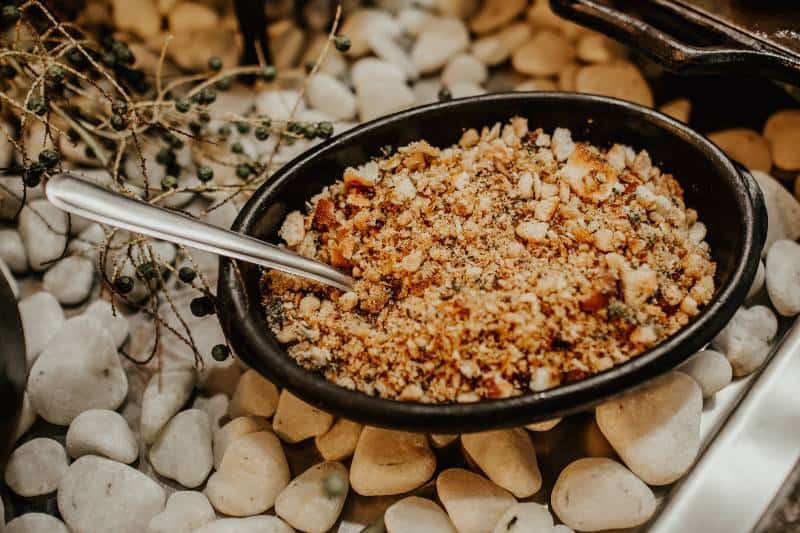
Farofa is a type of traditional Brazilian food that is made from toasted cassava or cornflour. The dish is so popular that it’s possible to buy commercially produced and packaged Farofa, but it tastes much better when it is prepared at home.
Because of the immense popularity of this staple Brazilian food, there are countless different recipes for Farofa. A typical recipe for the dish will call for raw cassava flour, butter, vegetable oil, onions, garlic, bacon, sausage, and olives.
All the ingredients should be toasted together until they’re golden brown, and you’ll know you’ve gotten it right if the Farofa has a smoky and salty taste.
Farofa is traditionally served as a side dish to a meat course. The staple smoky flavor of the dish really accentuates the flavor of meat, which is precisely why it’s so popular in Brazilian barbecues!
Creme de Cupuaçu (Cupuaçu Cream)
Creme de cupuaçu is a popular Brazilian dessert. The main ingredient is cupuaçu, which is a type of fruit that is native to the Amazon jungle. It has a very sour flavor, and it’s a bit hard to enjoy on its own, especially if you have a sensitive stomach.
Despite the acidic taste, cupuaçu is the most popular ingredient for most Brazilian desserts. The pulp of the fruit is mixed with a lot of sugar, condensed milk, and heavy cream.
Those are the staple ingredients at least, but it’s worth noting that there are a lot of different ways of making this Brazilian dessert. Some recipes use gelatin to manipulate the texture, and others will add nuts, fruits, and even some chocolate to the cream.
There’s even a version of the recipe that calls for layers of brigadeiro and cupuaçu cream, and it’s probably the best one to try if you usually prefer chocolatey desserts.
Picanha (Steak)
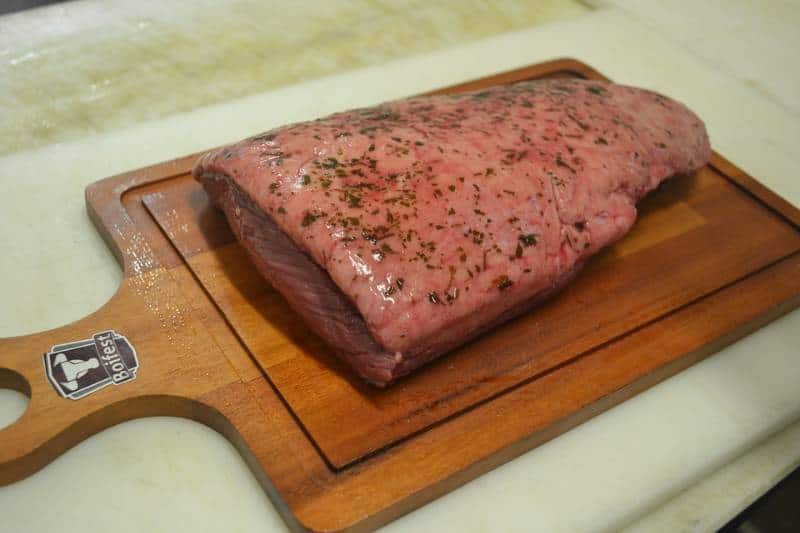
Picanha is the top sirloin cap cut of beef. It was first made popular in Brazil, and later it became very popular in Portugal as well. This is considered the most prized cut of beef in this South American country, and the fat cap isn’t removed until the steak is entirely cooked.
The Picanha steak is very popular in Brazilian barbecues, but it’s also often prepared on regular kitchen stoves. Most home cooks will cut the steak into the strips and skewer it because this allows the seasonings to penetrate every bit of the steak.
But, how is it seasoned? Well, you’re supposed to cut a cross-hatch pattern in the fat, without cutting into the meat part of the steak. Then put salt, pepper, and any other seasoning you might like on top of the fat, and massage it into the crevices.
Most of the fat melts during cooking, allowing the seasonings to kind of drip onto the meat. This is slightly better than seasoning the meat directly, and it pretty much eliminates the chances of overdoing it or having burnt parts of your steak.
The fat adds a lot of flavor to the steak, so you don’t have to remove it if you’re fine with eating it. But you can just separate it from the meat if you don’t like eating fat – if prepared right, it will be delicious enough even without the cap.
Pato no Tucupi (Duck Boiled in Tucupi Sauce)

Pato no Tucupi is a traditional Brazilian food that’s most commonly found in the Pará state, and around Belém city.
Pato is boiled duck, and tucupi is a type of yellow sauce that is extracted from manioc root. Jambu, a herb that’s typical in the northern areas of Brazil, is another staple ingredient in this dish.
Tucupi Duck is usually served with some type of starch, most commonly just white rice or cassava water flour. This is one of the main traditional dishes that are served during Círio de Nazaré, which is one of the world’s largest festivities in honor of the Virgin Mary.
Manioc root is easily found in the Amazon jungle, which is exactly why this dish is most popular in the state that’s closest to the jungle. Tucupi can also be produced as a by-product of manioc flour. However, it’s worth noting that the juice shouldn’t be eaten raw – it contains hydrocyanic acid, which is toxic for humans.
Tucupi should be boiled for 3-5 days at least, to allow to poisonous liquid to evaporate. Although Pato no Tucupi is a delicious traditional dish worth trying, it’s recommended that you only order this in well-known restaurants.
In other words, if a restaurant seems at all shady or not up to your standards, just don’t order the one dish that can be poisonous if it’s not prepared perfectly.
Mousse de Maracujá
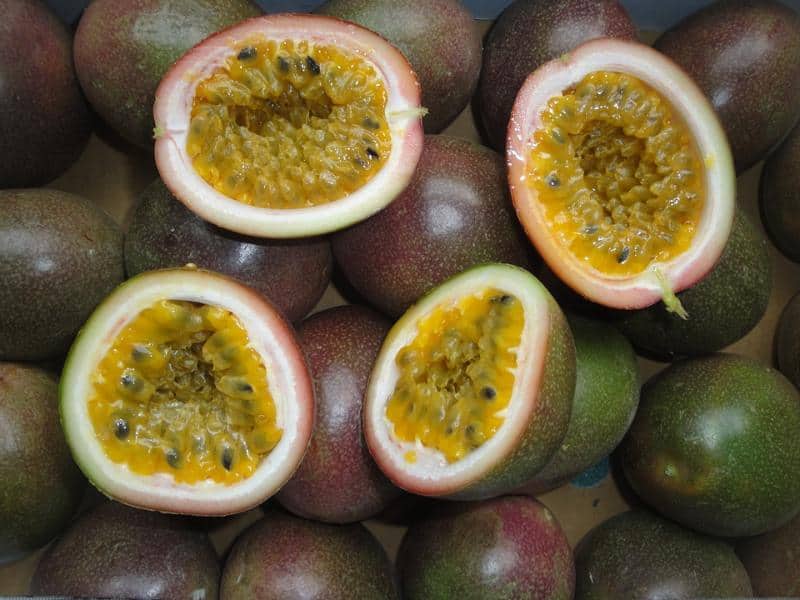
Mousse de maracujá is another popular dessert in Brazillian cuisine. The key ingredient is maracujá (passion fruit), and other staple ingredients are sweetened condensed milk, gelatin, and whipped egg whites.
The mousse can also be made with frozen passion fruit pulp or even just concentrated fruit juice, but it tastes best when it’s made with fresh maracujá.
This popular dessert is served cold, and its texture is a bit different from what you might be used to with traditional mousses. It’s not quite as aerated, and that’s mostly due to the gelatin in the mixture.
Some recipes even use heavy cream instead of the beaten egg whites, and they have a much creamier texture, almost like a pudding.
The mousse is usually topped with passion fruit seeds, which give it a very citric flavor. It’s also very light, making it a perfect summer treat. If you’re a sweet tooth, this should definitely be on your list of Brazilian desserts that you need to try!
Carne de Sol (“Sun Meat”)
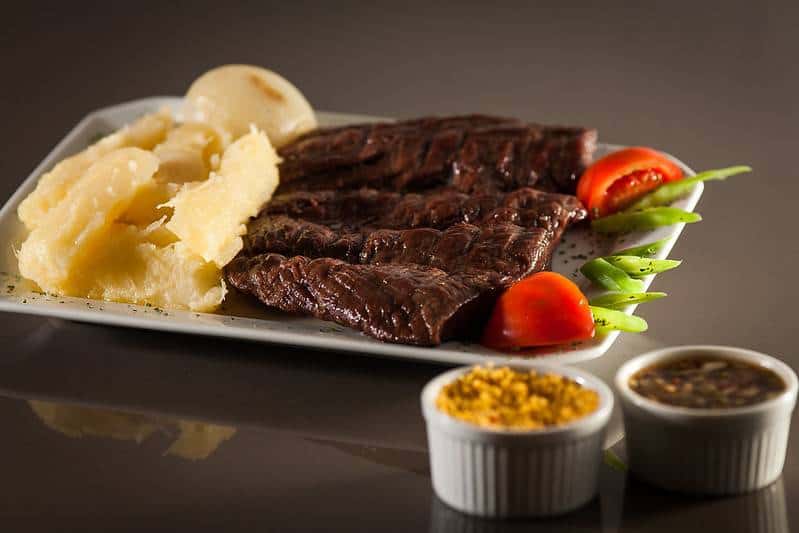
Carne de Sol translates to Sun Meat, which loosely describes the method of preparing this popular Brazilian food. Beef is heavily salted and then left to cure in the sun for one or two days. It can be then fried or baked in the oven, but most commonly it is just prepared as savory paçoca.
Also, it’s worth noting that the recipe has evolved quite a bit over the years, and nowadays it can be prepared without leaving the meat out in the sun. You just need salt, brown sugar, and about two days to get that smooth texture and very strong flavor that this dish is known for.
About the Author Anna Timbrook
Anna is the co-owner of expert world travel and can't wait to share her travel experience with the world. With over 54 countries under her belt she has a lot to write about! Including those insane encounters with black bears in Canada.

